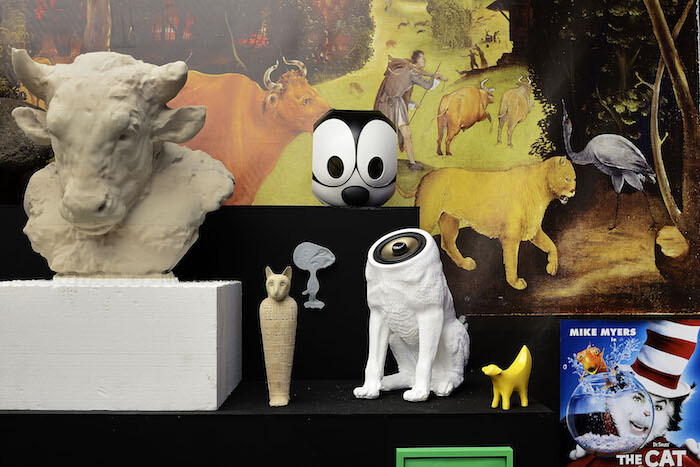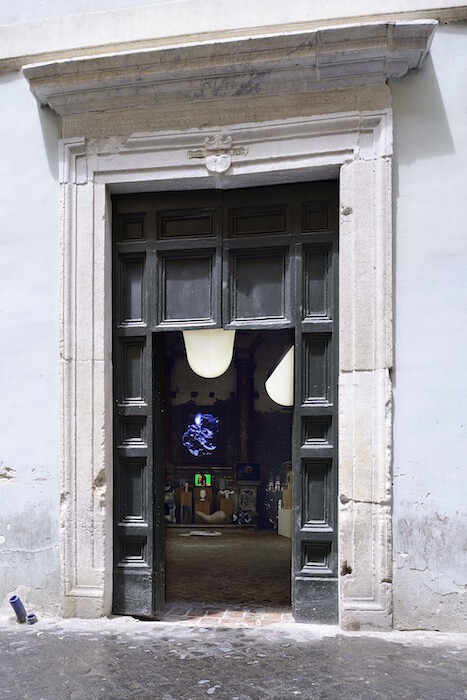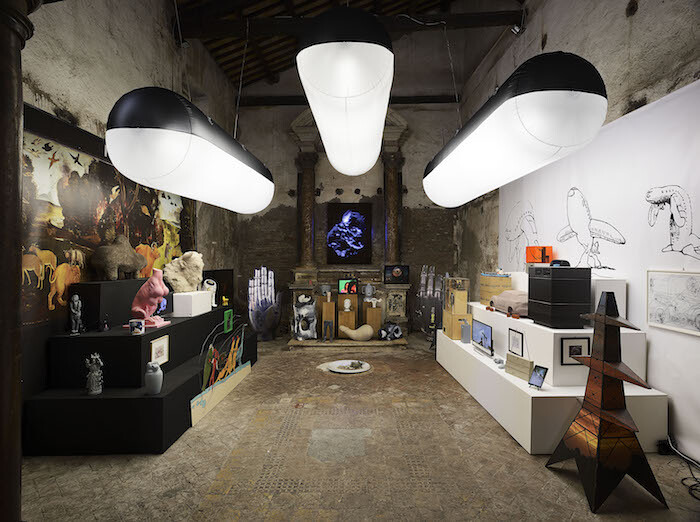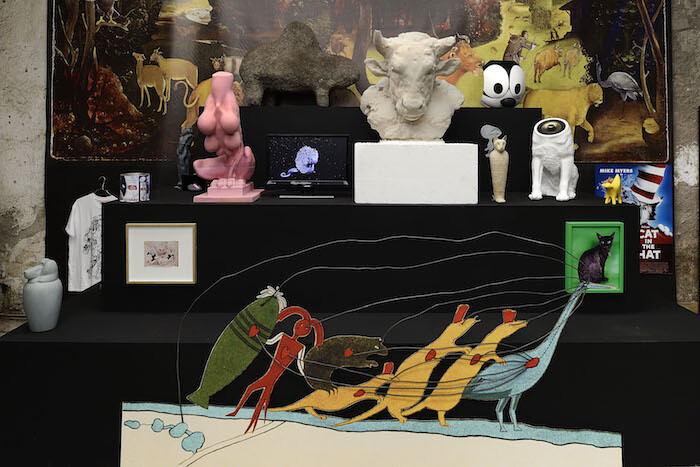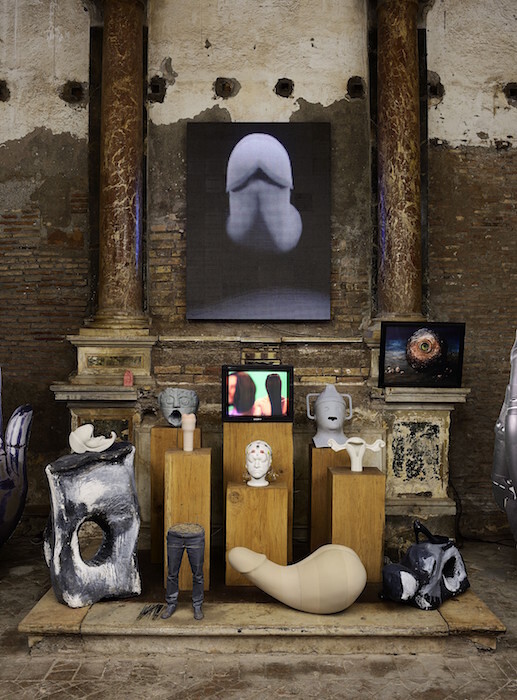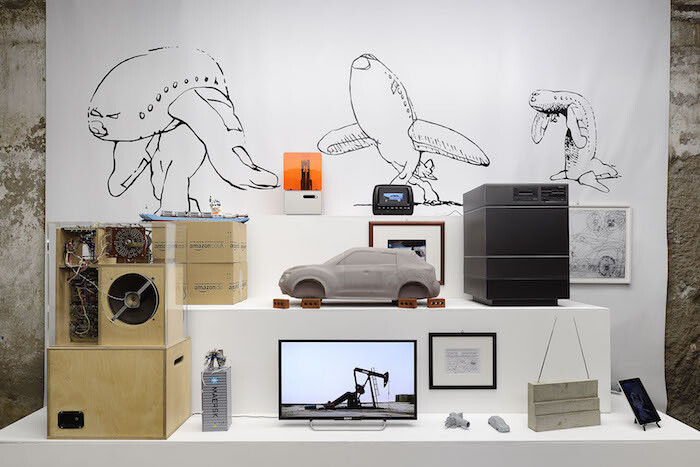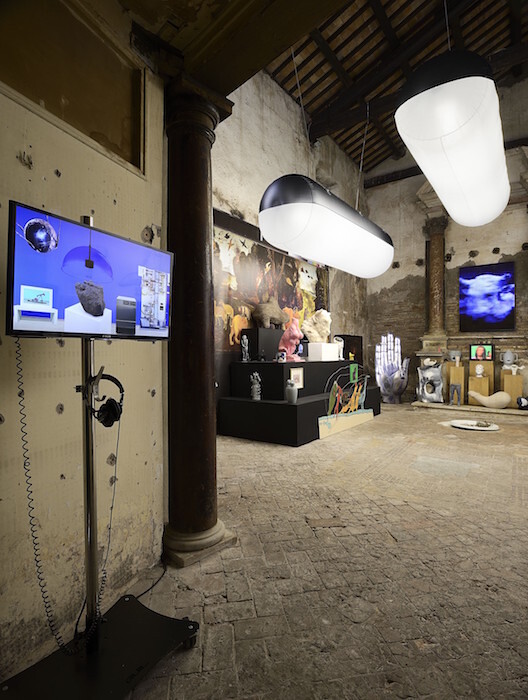Mark Leckey’s exhibition at Sant’Andrea de Scaphis, the Roman location of Gavin Brown’s enterprise, is the latest iteration of a series running back to the 2013 Hayward Touring show “The Universal Addressability of Dumb Things.” The original display took inspiration from digital images collected on Leckey’s hard drive, physical instantiations of which were assembled into an eccentric taxonomy. At Kunsthalle Basel, Leckey presented an “ersatz” version of the concept titled “UniAddDumThs” (2015), featuring replicas of the original objects. Considering these previous presentations, in what way does this new project add to the previous ones from which it takes its cue? And to what extent does it need everything that precedes it in order to be understood? Can we individuate a fissure, a difference that makes it unique and independent from its predecessors?
To address these questions, let’s imagine we don’t know anything of Leckey’s previous shows. We walk through the main door of this deconsecrated church to find an orderly arrangement of things. We might ask ourselves, “Is there an order that defines this set of objects? Why are they all together in one room? Why these and not others?” A number of 3D printed objects, two-dimensional prints, and videos are all laid out according to some inscrutable hierarchy along three sides of the wall, and illuminated by large inflatable lights. A copy of a hand reliquary (circa 1250) mirrors a 2D reproduction of the “i-limb ultra prosthetic hand” designed by Touch Bionics; a 3D printed version of a Hapi canopic jar faces a video display reproducing Chris Cunningham’s music video for Aphex Twin’s Windowlicker (1999) with no audio; a rare example of the Wurlitzer Sideman drum machine shares the same shelf as a 3D copy of Miroslav Tichý’s homemade camera.
Out of the initial confusion, some first key concepts begin to appear: evolving, knock-offs, reproductions, pulsating, simulacra. The installation evolves, mutates over time, the objects change, leaving behind secondary traces (which become primary). These objects are simulacra, reproductions whose appearance doesn’t refer to any concrete reality. They are copies of themselves, reproductions of an absence. Pulsating objects that live in several worlds, despite our presence. “A show populated by things that have one foot in this world and one in another,” Leckey repeats in the video that opens the exhibition. The artist talks insistently about a “proposal for a show,” but if he’s talking about a proposal, then what are we looking at? The exhibition is there, but continues also to not be there, to be a potential space, which exists in the present and in the past. What Leckey seems to indicate to the visitor is in a half-way world, a dimension that crosses the understanding of the human being as both a perceptive and an historical entity.
Let’s revisit the initial question and reformulate it: “If the exhibition presented in Rome is a new version of ‘The Universal Addressability of Dumb Things,’ how is this project re-articulated in the evocative space of Sant’Andrea de Scaphis?” Considering that the collection is undergoing a slow and constant process of substitution, that the original objects are being gradually replaced by 3D versions of themselves, introducing the fundamental notion that present and past are no longer juxtaposed, the past doesn’t have to make space for the present, and vice versa. As Leckey says in the video, “the movement of time has been converted into an arrangement of space… I imagine a newly born limb, the ghost of a flea, and an endless note petrified in stone; I picture two prosthetic arms, one ancient, one modern, reaching out as far as they can to grasp all that there is in the world.”
In approaching Leckey’s work, we should resist two temptations: the first is insisting on will, on the human-demiurgic act that established the connections. The second is the unreflexive attempt to conceptually align this operation with the “technological question” tout court. Confronting the by now almost irremediable opacity of the objects that surround us, an opacity that is not just symbolic and linguistic but also political and social (“the internet of things”), Leckey’s gesture is not one of mere assemblage, “curation,” or symbolic selection. Yes, there are shelves in the room that hold objects we assume to be presences on show, but that’s not the point. “UniAddDumThs” produces an evocative atmosphere, but it shouldn’t be understood as a modern Wunderkammer; we shouldn’t stop at the archaic attraction of the “cabinet of curiosities,” but instead consider Leckey’s repositioning of the very act of representing objects which participate in a web of relations that they themselves incarnate and enact. It is precisely the objects, those particular objects, which found a common dimension that is simultaneously a physical place and, for example, the possible materialization of a folder on the desktop of someone’s computer. It’s their presence-absence that creates this potential opening, the same problematic dimension that, by alternative routes, has insinuated itself into the history of mankind in the form of technology and mythology.
“UniAddDumThs” is an organism composed of things that find themselves grouped together because of a space-time curve operated by Leckey. As though his hand, pressing on a surface, made the objects upon it converge on that particular point, without entering into conflict with each other. The magical dimension of doing, of assembling—that is, the human act—is not what counts here. If anything, the magic lies in the phantasmal dimension of technology as a virtual space of thought. The most significant aspect of this new work by Leckey is the fact that it confuses the spatial and temporal planes, so that it no longer matters whether we really are inside a church full of objects or whether their presence makes us feel as if we are in a world of things.
